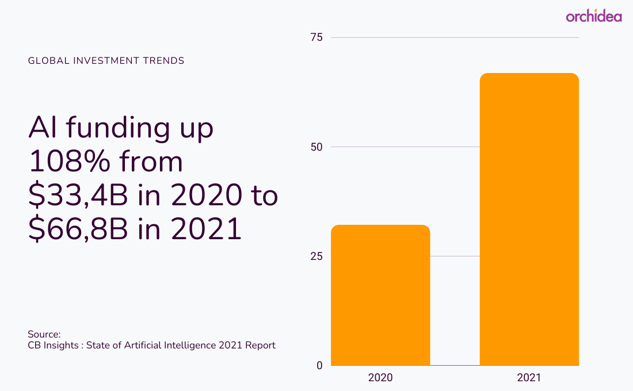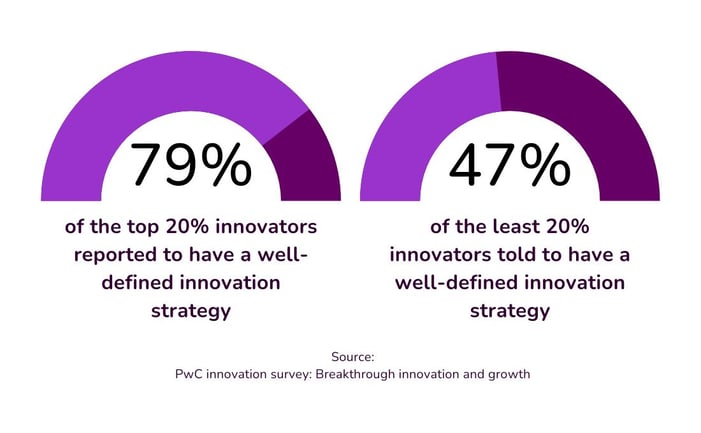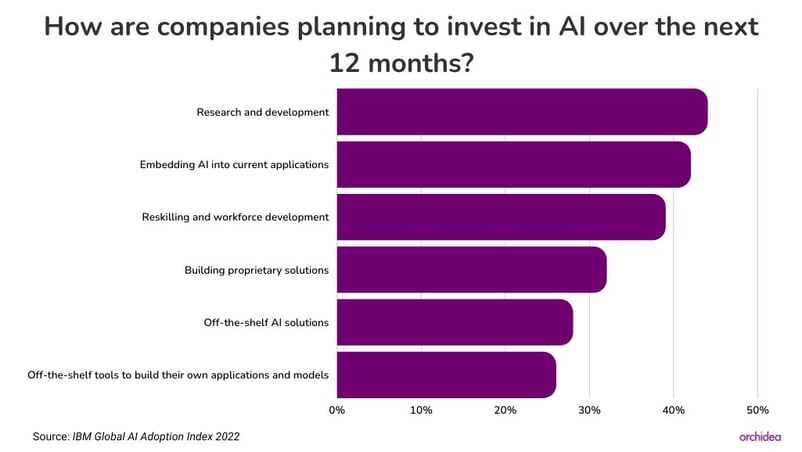Innovation has become the driving force behind progress and growth across industries. From groundbreaking technological advancements to cutting-edge strategies, the world is constantly evolving through the power of creative thinking and problem-solving. We evaluated multiple innovation studies and surveys to provide you latest insights on innovation and AI.
In this article, we present 42 eye-opening innovation statistics from sources like the PwC innovation survey, Gartner, Deloitte, and McKinsey. So let's dive in - here are some innovation research results that highlight the significance of innovation and its impact on our lives.
42 Innovation and AI statistics
- 87% of executives believe innovation is essential to their organization's success and growth. (McKinsey)
- By 2022, AI technologies are predicted to create 58 million new jobs worldwide, spanning industries and providing new opportunities for the workforce. (World Economic Forum, 2018)
- Companies that actively promote a culture of innovation are 3.5 times more likely to outperform their peers. (McKinsey, 2022)
- 61% of companies have made investments in AI. Notably, AI is drawing more investment from companies than any other technology. (BCG, 2023)
- The average lifespan of a company on the S&P 500 has decreased from 61 years in 1958 to just 18 years in 2011, emphasizing the importance of continuous innovation. (Innosight, 2015)
- 39% of CEOs reported that increasing R&D funding for sustainable innovation is a way to respond to sustainability challenges. (Accenture, 2022)
%20expenditure%20worldwide%20in%202022.jpg?width=1024&height=700&name=Leading%20countries%20by%20gross%20research%20and%20development%20(R%26D)%20expenditure%20worldwide%20in%202022.jpg)
- Just 30% of travel companies employ AI to facilitate the idea creation process, despite the fact that those in the travel industry who do utilize AI experience the most significant impact. (BCG, 2023)
- In 2022, the United States was the leading country in global R&D spending, accounting for approximately $679 billion. (Statista)
- AI funding increased 108%, from $32,1B to $66,8B in 2021. Healthcare funding was nearly a fifth of the total amount. (CBINSIGHTS, 2021)

- China has become a major innovation hub, with nearly half of the world's total patent filings coming from Chinese entities. (WIPO)
- AI implementation is expected to boost labor productivity by up to 40% across various industries by 2035, augmenting human capabilities (Accenture, 2016)
- By 2025, 95% of customer interactions will be powered by AI-driven technologies, enabling seamless and personalized experiences. (Servion Global Solutions)

- 78% of millennials consider innovation to be a key factor when choosing an employer. (Deloitte, 2014)
- AI-powered product recommendations are responsible for 35% of Amazon's revenue and have become crucial in driving sales in the e-commerce industry. (McKinsey)
- By 2026, over 75% of supply chain management vendors will include advanced analytics, AI, and data science in their applications. (Gartner)
- 29% of companies across industries reported to use AI to support their idea creation process. (BCG, 2023)
- Highly innovative companies prioritize collaboration more than their less innovative counterparts. When it comes to jointly developing new products and services with external partners, the most innovative companies do so over three times more frequently (34%) than the least innovative ones (10%). (PwC)
- The quality of ideas generated by ChatGPT, as assessed by purchase intent, surpasses the average quality of ideas generated by humans. (Girotra, et al. 2023)
- Between 2018 and 2022, applied AI consistently achieved the highest innovation scores among all the studied trends, and its investment score consistently ranked among the top five. Notably, in 2022, the demand for talent in applied AI surpassed that of all other trends. (McKinsey)
- The pharmaceutical industry invests approximately 20% of its revenue in R&D. (PhRMA)
- In 2022, organizations utilized an average of 3.8 AI capabilities, such as natural language generation and computer vision, which is double the 1.9 capabilities used in 2018. (McKinsey, 2023)

- 44% of companies reported to use AI in the idea generation process such as validating and surfacing the ideas. (BCG, 2023)
- In 2021, women represented just 16.5% of international patent applications, and a mere one-third of all patent applications included at least one woman inventor. (WIPO)
- Companies that have experienced the most significant bottom-line gains from applied AI, attributing at least 20 percent of their EBIT to AI utilization, tend to have positioned themselves for success through the alignment of their AI and business strategies. (McKinsey, 2023)
- Companies that sought innovation ideas from external sources were more likely to achieve top performance in revenue growth, profitability, and innovation. (PwC)
- Companies that prioritize diversity and inclusion are 1.7 times more likely to be innovation leaders. (Josh Bersin & Deloitte)
- 54% of AI projects successfully transition from the pilot phase to production on average. (Gartner)
- On average, it takes about 10-15 years for a new medicine to be developed and approved. (PhRMA)
- The most innovative companies, at 79%, possess well-defined innovation strategies, while just 47% of the least innovative ones do. (PwC)
- Pharmaceutical firms are using AI to cut costs and reduce traditional method risks. The sector's AI market is estimated a 40% expected growth from 2017 to 2024. (Link)

- In 2022, 35% of companies are actively using AI in their operations, with another 42% in the process of exploring AI. This represents a continuous growth, up by four points compared to 2021. (IBM, 2022)
- In the survey, 79% of leaders indicated that they had fully deployed three or more types of AI applications. (Deloitte)
- Enhancing innovation capabilities is identified as a crucial motivator for CEOs in building diverse and dynamic partnerships, with 40% of them highlighting this factor. (PwC)
- By 2025, AI-generated content is predicted to be 30% of outbound marketing of big corporations. (Gartner)
- By 2030, AI could contribute $15.7 trillion to the global economy, exceeding China and India's combined output. Out of this, $6.6 trillion would come from increased productivity, while $9.1 trillion would result from consumption-side effects. (PwC)
- 37% of companies reported to use AI in current research and development processes. (Deloitte, 2022)

- Just around 52% reported to either strongly or moderately agree that they contribute new and innovative ideas to their team. (PwC, 2023)
- 76% of the survey participants expressed their intention to boost AI investments in order to maximize their benefits. (Deloitte)
- Research and development was the biggest category of investments in AI in next 12 months. 44% of companies was planning to allocate resources in this area. (IBM, 2022)
- Leading innovators view innovation as a disciplined and scalable business process. Only 20% of the most innovative companies manage innovation informally, whereas a third of the least innovative companies do so. (PwC)
- AI's application in environmental initiatives has the potential to increase global GDP by 3.1% to 4.4% and decrease global greenhouse gas emissions by approximately 1.5% to 4.0% by 2030. (PwC)
- Diverse management teams leads to more innovation. Companies with above-average diversity on their leadership teams reported 19% higher innovation revenue compared to those with below-average diversity. (BCG, 2018)
In conclusion, these innovation statistics underscore the transformative power of creative thinking and the imperative for businesses to embrace and foster a culture of innovation. By staying agile, investing in research and development, and leveraging emerging technologies, organizations can not only thrive but also lead the charge toward a brighter and more innovative future.
Hope you found these innovation statistics interesting. Share your thoughts in the comments below!



.jpg)

.jpg)